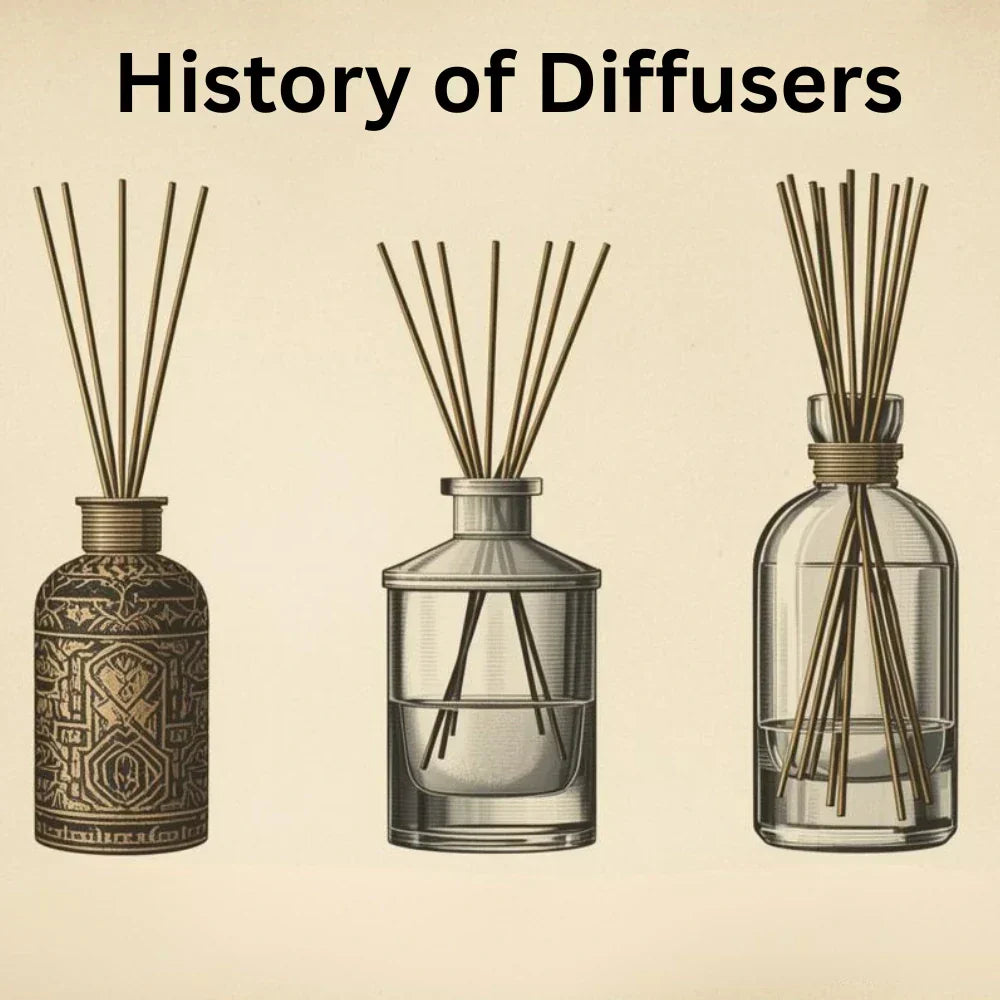
The History of Diffuser Bottles: Scent Through the Ages
Share
The History of Diffuser Bottles: Scent Through the Ages
Today, diffuser bottles are everywhere, in homes, spas, boutiques, and offices offering elegant ways to subtly scent a space. But the use of scent diffusers is far from new. In fact, the history of diffuser bottles spans centuries and continents, blending ancient traditions with modern design. In this post, we’ll explore the fascinating evolution of diffuser bottles, from their earliest forms to the stylish versions we see today.
1. Ancient Beginnings: Fragrance in Early Civilizations
The story of diffuser bottles begins in the ancient world, where scent held both spiritual and practical significance.
- Egypt (c. 3000 BCE): Egyptians were pioneers in using aromatic oils for rituals, embalming, and personal scent. Though not reed diffusers, they used clay pots and stone jars to store fragrant oils, which were heated or poured over bodies and garments.
- India and China: Both cultures embraced the use of essential oils and incense. While incense was more common, oil diffusing also existed, often through terracotta vessels that allowed oils to evaporate slowly into the air.
- Greece and Rome: The wealthy elite used alabaster and glass bottles to store perfumed oils, which were then applied directly or used in steam rooms to scent the air. These ornate vessels were often beautiful works of art in themselves.

2. The Middle Ages to the Renaissance: The Age of Perfumed Vessels
During the Middle Ages in Europe, fragrance use took on a more medicinal and spiritual role.
- Pomanders and Clay Jars: Scented materials were kept in perforated containers to ward off disease (as it was believed that bad smells carried illness). Ceramic vessels with fragrant oils began appearing in wealthier households.
- Renaissance Europe: Perfume culture flourished, especially in France and Italy. Glass-blown perfume bottles became highly sought after. While these were for personal fragrance, their design directly influenced the later diffuser bottle aesthetic.

3. The 19th Century: Industrialization and the Rise of Home Fragrance
With the rise of the industrial age, fragrance production became more accessible.
- Perfume Bottles Go Mainstream: Bottles were no longer only for the elite. Ornate cut-glass bottles filled with fragrant oils became common household items.
- Early Diffusing Techniques: People would place oil-soaked cotton balls in bowls or use porous ceramic containers to subtly disperse scent through a room, a precursor to the modern diffuser.
4. The 20th Century: Innovation Meets Aesthetics
The 20th century saw the first real shift toward purpose-built scent diffusers for home use.
- Electric Diffusers: In the mid-1900s, plug-in and heat-based oil diffusers emerged, offering more control over scent strength and longevity.
- Reed Diffusers (Late 20th Century): The exact origin is debated, but reed diffusers became popular in the 1980s–90s as a flameless, low-maintenance alternative to candles and incense. The concept uses porous reeds placed in a bottle of fragrance oil, slowly absorbing and releasing the scent into the air.
- Design Becomes Key: Diffuser bottles evolved from simple containers into decor pieces with stylish glass, ceramic, and stoneware vessels becoming part of interior design trends.

5. The 21st Century: Sustainability and Customization
In recent years, consumer preferences have shaped the next wave of diffuser bottle evolution:
- Eco-Friendly Materials: Recycled glass, refillable bottles, and biodegradable reeds cater to environmentally conscious users.
- DIY Culture: People are now crafting their own diffuser blends at home, choosing custom scents and bottle designs to match their lifestyle and decor.
- Luxury Meets Wellness: High-end diffuser bottles now double as luxury decor and wellness tools, using essential oils for aromatherapy benefits.

From ancient rituals to modern self-care, diffuser bottles have a rich and varied history. What began as clay pots filled with oils in ancient temples has transformed into a stylish and sensory staple in homes around the world. Today’s diffuser bottles are more than just vessels for fragrance, they’re a blend of history, artistry, and wellness.
So next time you flip your diffuser reeds or admire the bottle on your shelf, remember you’re participating in a centuries-old tradition of using scent to enhance space, mood, and memory.
